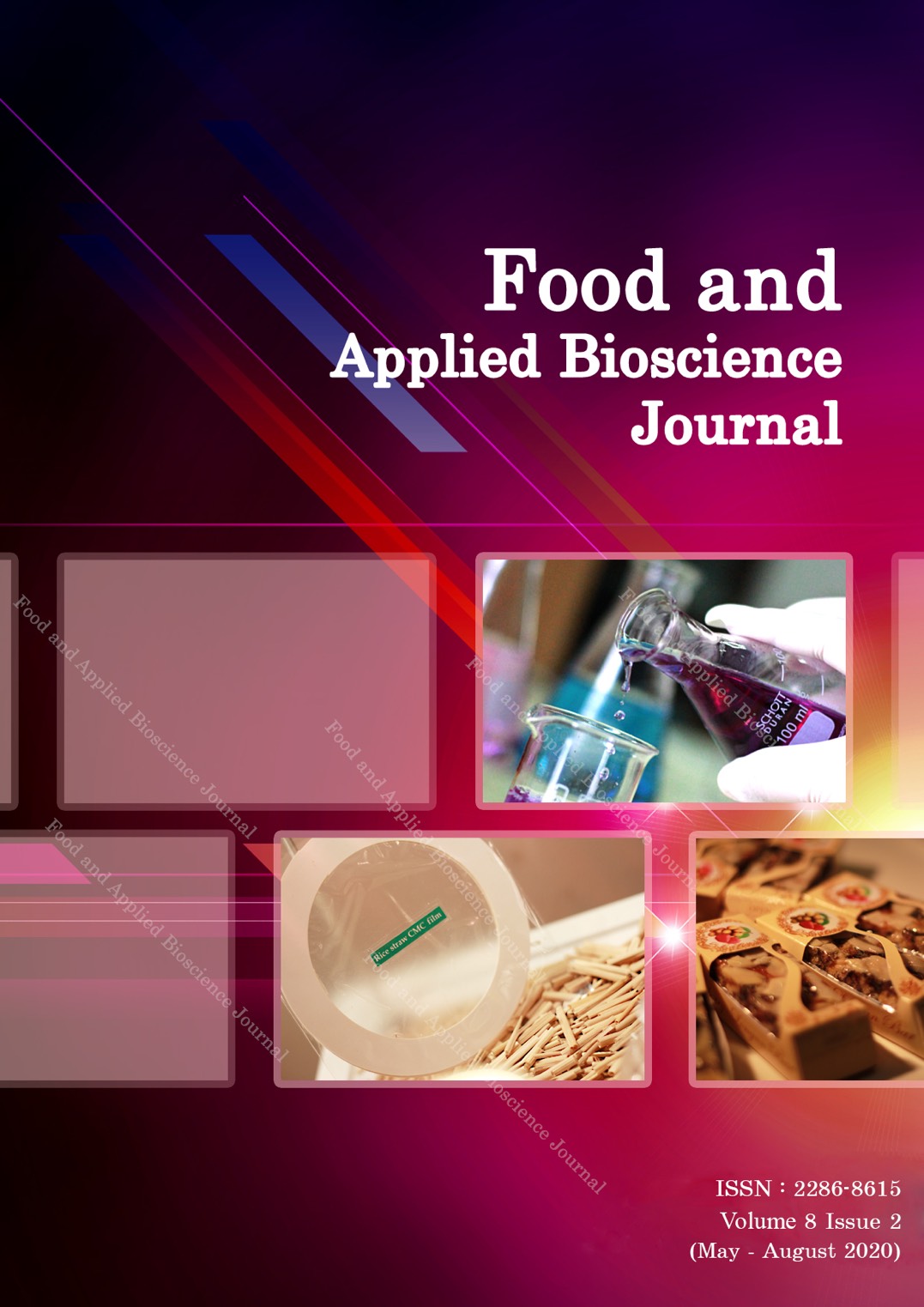Anti-hairloss efficacy of coffee berry extract
Keywords:
Coffee berry, Caffeine, Hair loss, 5-alpha-reductase, Spray tonicAbstract
An important enzyme causing hair loss in human is 5−alpha−reductase by catalyzing the conversion of testosterone to dihydrotestosterone (DHT) which induced miniaturization of the hair follicle. Coffee berry is a natural source of caffeine and chlorogenic acid which shows inhibition of the enzyme activity. The objective of this research was to determine the total phenolic content, DPPH radical scavenging and inhibition of 5−alpha reductase activities of coffee berry extract and evaluate anti−hair loss efficacy of tonic containing the extract on 47 volunteers. Coffee berry extract showed high quantity of caffeine
0.43 mg/mL by HPLC technique. The total phenolic content was found to be 0.73 ± 0.02 mg GAE/mL extract. The DPPH radical scavenging of the extract showed the IC50 value of 4.10 ± 0.29 mg/mL. The cytotoxicity and 5−alpha−reductase inhibition of the extracts were investigated on prostate cancer cell lines (DU−145). The cell viability of coffee berry extract at concentration 0.1, 1, 10, 100 and 1,000 µg/mL showed 102.8, 97.6, 91.8, 97.7 and 88.8%, respectively, which indicating that the extract has not cytotoxic on the cell lines. The coffee berry extract at 1,000 µg/mL was selected to evaluate 5−alpha−reductase inhibition. The extract showed slightly lower inhibition of 5−alpha−reductase activity with 16.5% than the standards, finasteride (32.5%) and dutasteride (20.1%). In clinical trial, 13 male and 34 female volunteers who have hair loss problem were selected and divided randomly into two groups. First group applied placebo spray tonic (C) and the second group applied spray tonic containing 10% coffee berry extract (CB) everyday for 12 weeks. The volunteers were assessed for hair loss reduction by one−minute combing test every month. The CB group showed significant reduction in the mean number of hairs loss after combing test from 11.5 to 2.4, 1.9 and 1.4 (P<0.01) for 1, 2 and 3 months, respectively. The CB group showed better efficacy for hair loss reducing than placebo. In conclusion, the results indicated that coffee berry can be used as anti-hair loss ingredient in hair care cosmetics.
References
Dizalo M., Mierziak J., Korzun U., Preisner M., Szopa J., and Kulma A. 2016. The potential of plant phenolics in prevention and therapy of skin disorders. International Journal of Molecular Sciences. 17 (2): 1-41.
Farah A. 2012. Coffee constituents. John Wiley & Sons, Inc. and the institute of food technologist.
Geremu M., Tola B. Y., and Sualeh A. 2016. Extraction and determination of total polyphenols and antioxidant capacity of red coffee (coffee arabica L.) pulp of wet processing plants. Chemical and Biological Technologies in Agriculture.
Ghanaat M., 2010. Types of hair loss and treatment options, inluding the novel low-level light theraphy and its proposed mechanism. Southern Medical Journal. 103 (9).
Kiattisin K., Nantarat T., and Leelapornpisid P. 2016. Evaluation of antioxidant and anti-tyrosinase activities as well as stability of green and roasted coffee bean extracts from coffee arabica and coffee canephora grown in Thailand. Journal of Pharmacognosy and Phytotheraphy. 8 (10): 182-189.
Komes D., and Bušic A. 2014. Antioxidants in coffee. Processing and Impact on Antixidants in Beverages.
Madan A., Arun A., and Verma S. 2014. A non comparative open label pilots study to see the efficacy and consumer response of vegetal hair well in preventing hair fall and promoting hair growth. International Journal of Advanced Research. 2 (2): 475-481.
Poltronieri P., and Rossi F. 2016. Challenges in specialty coffee processing and quality assurance. Challenge. 7 (19).
Prince V.H. 2003. Androgenetic alopecia in women. The Society forIncestigative Dermatology. 8 (1).
Ramos M. P., and Milot A. H. 2015. Female pattern hair loss: a clinical and pathophysiological review. Anais Brasileiros Dermatologia. 90 (4): 529-543.
Rawal R. And Kolhapure S. A., 2005. Evaluation the efficacy and safety of “Hair loss cream” in the management of telogen effluvium. 16 (5): 19-26.
Ruksiriwanich W., Manosroi J., Abe M. and Manosroi W. 2011. 5α-reductase type 1 inhibition of oryza sativa bran extract prepared by supercritical carbon dioxide fluid. The Journal of Supercritical Fluids. 61-71.
Schnuch A., Aberer W., Agathos M., Becker D., Brasch J., Elsner P., Frosch J. P., Fuchs T., Geier J., Hillen U., Löffler H., Mahler V., Richter G., and Szliska C. 2008. Patch testing with contact allergens, guideline of the German dermatologic society (DDG) and the German society for allergy and clinical immunology (DGAKI). Journal Compilation. 770-775.
Trüeh M. R. 2011. Oxidative stress in Ageing of hair. International Journal of Trichology. 1 (1): 6-14.
Vichit W., and Saewan N. 2015. Antioxidant activities and cytotoxicity of Thai pigmented rice. International Journal of Pharmacy and Pharmaceutical Sciences. 7 (7): 329-334.
Vichit W., and Saewan N. 2016. Effect of germination on antioxidant, anti-inflammatory and keratinocyte proliferation of rice. International Food Research Journal. 23 (5).,






